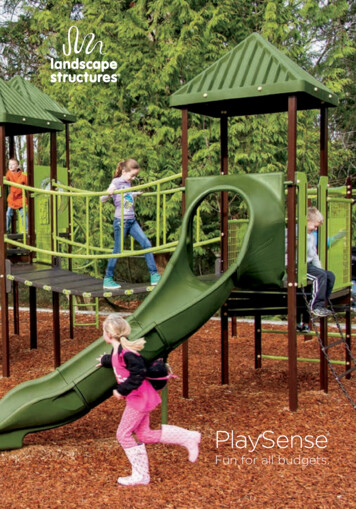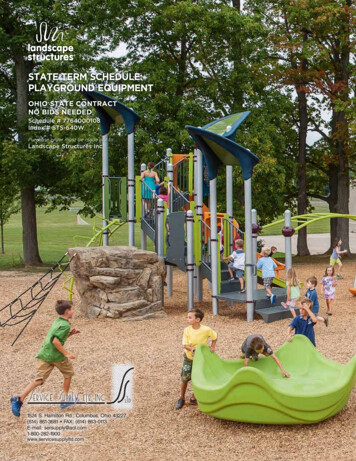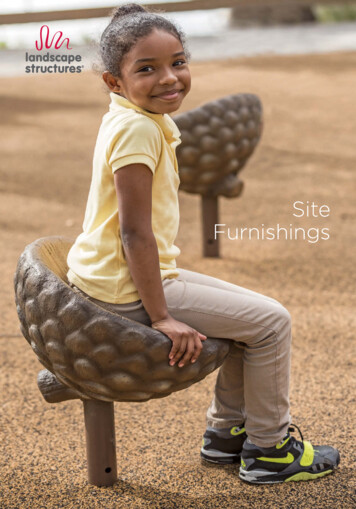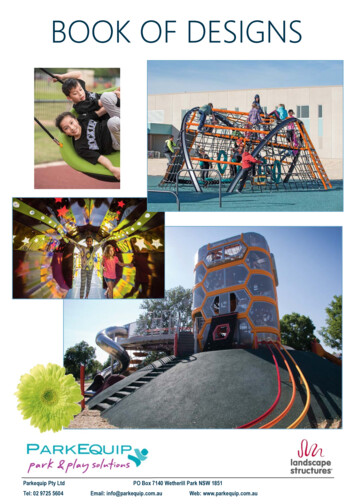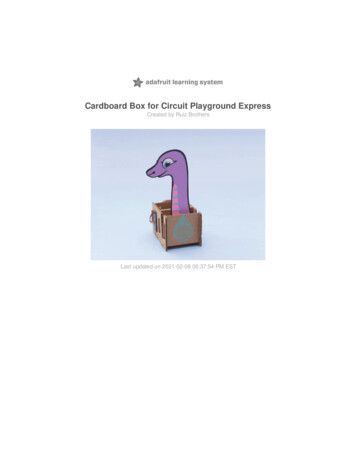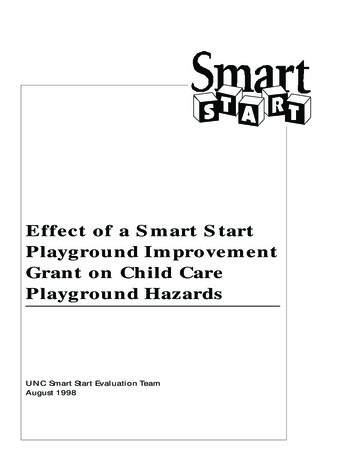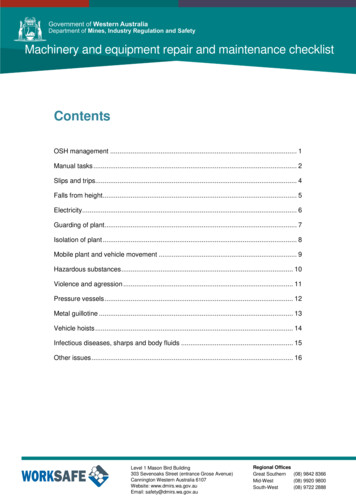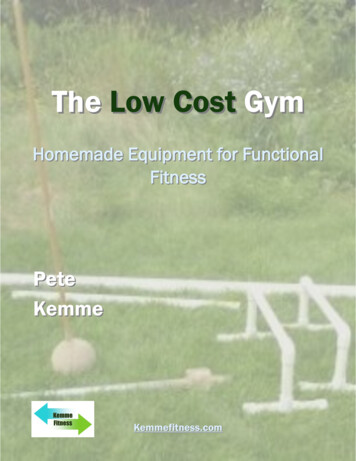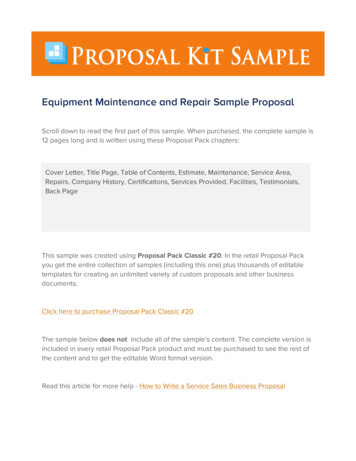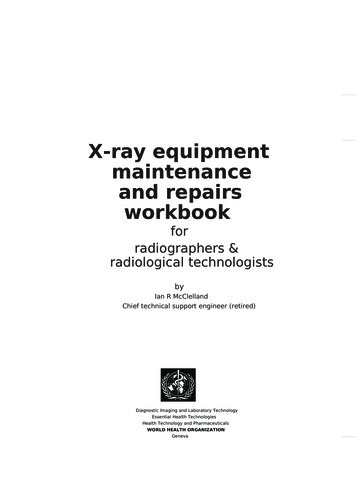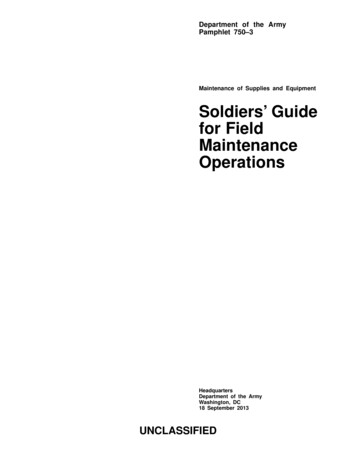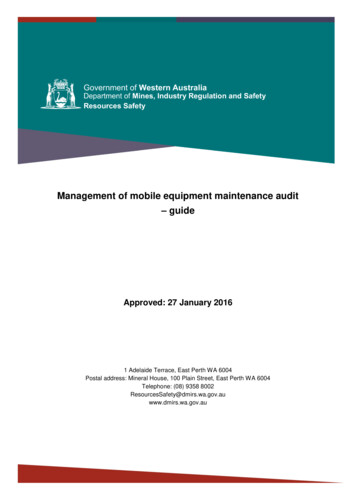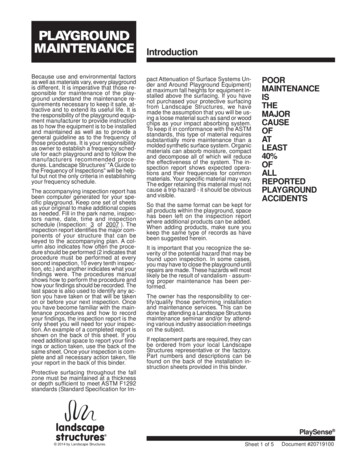
Transcription
IntroductionBecause use and environmental factorsas well as materials vary, every playgroundis different. It is imperative that those responsible for maintenance of the playground understand the maintenance requirements necessary to keep it safe, attractive and to extend its useful life. It isthe responsibility of the playground equipment manufacturer to provide instructionas to how the equipment is to be installedand maintained as well as to provide ageneral guideline as to the frequency ofthose procedures. It is your responsibilityas owner to establish a frequency schedule for each playground and to follow themanufacturers recommended procedures. Landscape Structures' "A Guide tothe Frequency of Inspections" will be helpful but not the only criteria in establishingyour frequency schedule.The accompanying inspection report hasbeen computer generated for your specific playground. Keep one set of sheetsas your original to make additional copiesas needed. Fill in the park name, inspectors name, date, time and inspectionschedule (Inspection: 3 of 2007 ). Theinspection report identifies the major components of your structure that can bekeyed to the accompanying plan. A column also indicates how often the procedure should be performed (2 indicates thatprocedure must be performed at everysecond inspection, 10 every tenth inspection, etc.) and another indicates what yourfindings were. The procedures manualshows how to perform the procedure andhow your findings should be recorded. Thelast space is also used to identify any action you have taken or that will be takenon or before your next inspection. Onceyou have become familiar with the maintenance procedures and how to recordyour findings, the inspection report is theonly sheet you will need for your inspection. An example of a completed report isshown on the back of this sheet. If youneed additional space to report your findings or action taken, use the back of thesame sheet. Once your inspection is complete and all necessary action taken, fileyour report in the back of this binder.pact Attenuation of Surface Systems Under and Around Playground Equipment)at maximum fall heights for equipment installed above the surfacing. If you havenot purchased your protective surfacingfrom Landscape Structures, we havemade the assumption that you will be using a loose material such as sand or woodchips as your impact absorbing system.To keep it in conformance with the ASTMstandards, this type of material requiressubstantially more maintenance than amolded synthetic surface system. Organicmaterials can absorb moisture, compactand decompose all of which will reducethe effectiveness of the system. The inspection report shows expected operations and their frequencies for commonmaterials. Your specific material may vary.The edger retaining this material must notcause a trip hazard - it should be obviousand visible.So that the same format can be kept forall products within the playground, spacehas been left on the inspection reportwhere additional products can be added.When adding products, make sure youkeep the same type of records as havebeen suggested FALLREPORTEDPLAYGROUNDACCIDENTSIt is important that you recognize the severity of the potential hazard that may befound upon inspection. In some cases,you may have to close the playground untilrepairs are made. These hazards will mostlikely be the result of vandalism - assuming proper maintenance has been performed.The owner has the responsibility to certify/qualify those performing installationand maintenance services. This can bedone by attending a Landscape Structuresmaintenance seminar and/or by attending various industry association meetingson the subject.If replacement parts are required, they canbe ordered from your local LandscapeStructures representative or the factory.Part numbers and descriptions can befound on the back of the installation instruction sheets provided in this binder.Protective surfacing throughout the fallzone must be maintained at a thicknessor depth sufficient to meet ASTM F1292standards (Standard Specification for Im-PlaySense 2014 by Landscape Structures.Sheet 1 of 5Document #20719100
CompletingTheInspectionReportIndicates the date the playground equipment was installed.PlaySenseIndicates how oftenthese products are to beinspected.Name of person, agencyor company that originally installed the equipment.Product to be inspected.SlideWhat you found andwhat you did about it.Keep one copy of thisform as your originalto make copies as necessary.
A Guide to the Frequency of InspectionsEnter the factor points in the right hand column that best describes the conditions at the playground.Use FactorsIt is estimated that at least 40% of allaccidents on public playgrounds couldhave been prevented if a good preventative maintenance program werein place. A good program establishesa frequency of inspections that arecommensurate with the use and environmental factors unique to each playarea. Some playgrounds will requiredaily inspections while others in thesame area may require only bi-weeklyinspections. The deterioration and/orwear of various play components canbe predicted when certain factors areknown. On the other hand, vandalism has a major influence on the frequency of inspections but is not aspredictable.The following guide utilizes the mostcommon use and environmental factors that will influence your schedule.Each factor has been weighed as toits importance and influence on theschedule. Local conditions may include other factors, and in somecases, may affect seasonal adjustments to the schedule. Experience isyour best guide.Factor PointsVandalism.High - 10 pts.Moderate - 5 pts.Low - 2 pts.Use.High - 10 pts.Moderate - 5 pts.Low - 2 pts.Age.Preschool - 1 pt.School Age - 3 pts.All Ages - 2 pts.MaterialsProtective Surfacing.Loose Material - 18 pts.Unitary Material - 3 pts.Material of Major Components.Painted Steel - 4 pts.Plastics, Aluminum, Galvanized Steel - 2pts.Stainless Steel - 0 pts.Equipment.Moving: Gyro Twister, PodStomper etc. - 8 pts.Static: Non-Moving Climbers - 2 pts.Both - 8 pts.Enviormental FactorsSalt Air - Coastal Exposure.None - 0 pts.Moderate - 2 pts.High - 5 pts.Acid Soils/ Rain.None - 0 pts.Moderate - 1 pt.High - 2 pts.Sun Exposure.Low - 1 pt.Moderate - 2 pts.High - 4 pts.TotalEnter Total Points Here.See back to determine frequency of inspections. 2014 by Landscape Structures.Sheet 2 of 5Document #20719100
Your Total PointsRecommended Frequency of Inspections50 or MoreDaily Inspections40-50Weekly Inspections30-40BiMonthly InspectionsBelow 30Monthly InspectionsHigh FrequencyLow FrequencyNOTE:For your program to be effective, the inspectors mustbe properly trained. Call the equipment manufacturerif you are uncertain as to how a particular component should be inspected and when it should be replaced.Keep this worksheet with other documentation on this playground.DatePerson Completing WorksheetName/Address of PlaygroundRecommended Frequency of Inspections:High Use PeriodLow Use Period 2014 by Landscape Structures.601 7th Street South, Delano, Minnesota 55328-86058 (763)972-3391 FAX (763) 972-3185
FinishesTenderTuff-Coating, ie: Decks, Wheels, etc.1Cleaning: Apply “Graffiti Cleaner” to affected area. Follow the directions on the bottle. Heavy stains mayneed to be removed mechanically first (scrape with a knife or sandpaper). Seal the affected areawith “Clear Guard” by Turtle Wax or “Armor All” by Armor All. Buff the area until the colors blend.Repairing: TenderTuff Patch Kit required. This patch is recommended to replace worn or vandalized areasof TenderTuff-coating. It is a solvent formula that is air-curing formulated specifically for Landscape Structures.The temperature range for application is between forty and ninety degreesFahrenheit (40o-90oF). It should be applied on a dry day.Applying (137784) patch to a PVC coated surface.Clean surface, remove surface corrosion of steel with light sanding.Trim flat with PVC coated surface using a razor blade or knife.Apply enough patch to cover bare metal or gouged surface.Spread patch evenly with wet (water) finger, plastic, or knife.Patch will dry to touch in approximately 15-30 minutes depending on size of area.(During this time, it is advisable to keep the area restricted from users.)Patch may shrink, apply second coat if needed.Clean finger, plastic, or knife with rag or paper towel.Anodized, ie: Metal Climbers1Cleaning: Apply “Graffiti Cleaner” to affected area. Follow the directions on the bottle. Graffiti Cleanershould be used within 24 to 48 hours from the time the surface was affected with graffiti.Repairing: (Bronze Color) Repair scratches to bronze colored anodized surface, by applying a small amountof bronze colored paint to scratches, using brush and paint provided. Scratches on metal climbers with clear coat anodized finish, do not require repair.MaterialsPermalene Parts, ie: Learning Wall Panels, TuffRiders, etc.1Cleaning: Apply “Graffiti Cleaner” to affected area. Follow the directions on the bottle.Repairing: Scratches can be burnished away with a clean, blunt instrument.Poly Parts, ie: Slides, TuffTimbers, Tires, Number Discs, etc.1Cleaning: Apply “Graffiti Cleaner” to affected area. Follow the directions on the bottle.Repairing: Scratches can be sanded or burnished away with a clean, blunt instrument. Burnish until they"melt together". More significant repairs are not economically feasible.Polycarbonate Parts, ie: Windows, Bubbles, etc.1Cleaning: Use glass cleaner spray for cleaning. No abrasives.Repairing: Sharp corners from scratches can be burnished away with a clean, blunt instrument.Sheet 3 of 5 Document #20719100
Repair of PowdercoatingEquipment Required:Maintenance Repair KitAAWith emery cloth sand area to be repaired until all rust is removed. Be sureto rough and feather edges of surrounding powder coated area with 400 gritsandpaper until smooth.BBTo help assure best results be sure areas to be painted are clean and dry. Thiscan be accomplished by using a clothdampened with rubbing (isopropyl) alcohol or water.CCProtect adjacent areas from overspray,if necessary. Apply a minimum of 3 lightcoats of primer (supplied). Allow to dry'to the touch' between coats. Lightlysand with 400 grit sandpaper, then wipewith clean cloth. Use same method toapply a minimum of 3 light coats of paint.Be sure to allow areas to dry 3 of 4 hoursbefore use. (Drying time will vary)12"MIN.NOTE: Be sure to hold spray can12" - 14" from surface.PlaySense J:\SPECS\128\12894900.PM5 2014by Landscape Structures.
Maintenance/Inspection ProceduresLoose Protective Surfacing: Remove foreign materials from the play area. Rake protective surfacing level so it is upto the finished grade marks. Add protective surfacing materials as necessary to maintain the depth and performancerequired.Fasteners: Replace if pitted with corrosion or deformed. Tighten attachment fasteners as necessary.Nut Covers: Replace if cracked, seriously discolored or the cap is missing.Posts: Replace post if post is severely damaged or pitted with corrosion. Posts must be plumb & keep decks level- adjust if necessary.Decks: Replace if perforated area is sagged more than 1/2” or if welds are cracked or part is seriously deformed ordefaced. PVC coating can be repaired, call Basics Inc. or your local Rep for a repair kit.Poly Parts such as Slides, Roofs and Crawl Tunnels: Replace if cracked, embrittled or seriously discolored. Jointson slides must be tight between sections - loosen and adjust as necessary.Horizontal Ladders, Handrails, Loop Arches, Corkscrews and Firepoles: Replace if welds are cracked, deformed,or pitted with corrosion.Wire Barriers: Replace if welds are cracked, deformed or severely pitted with corrosion.Chinning Bars, Vertical Ladders, Transfer Handbars & Kick Plates: Replace if deformed, or pitted with corrosion.Clatterbridge Brackets & Planks: Replace if welds are cracked or parts are seriously deformed. Replace bushings inclatterbridge plank if 50% worn.Wiggle Ladders: Check chain only if TenderTuff-coating is cracked or worn away. Replace ladder if any link is 50% worn.Ring Bridges: Replace beam if welds are cracked, deformed or severely pitted with corrosion.Replace bolt links if worn 50% and “D” rings if deformed or connection is worn to 50% of bushing.Bubbles: Replace if severely scratched or if cracked 2” or longer. Cap screws should be snug only. (Do not overtighten!)Permalene Panels: Replace if cracked, embrittled or seriously discolored. Cuts and scratches can be burnishedaway with a clean blunt instrument.Talk Tubes: Replace if screen or any welds are cracked, deformed or pitted with corrosion. If talk tubes do not functionproperly, disconnect plastic tubing at elbows and blow water or sand out of tubing with an air compressor, then reconnectplastic tubing.Slide supports: Tighten cap screws. Replace if welds are cracked or the unit is deformed or pitted with corrosion.Concrete Footings: Shovel away protective surfacing and part of subsoil to inspect. Replace footing if it is cracked or nottight around post or subsoil. (May need to wiggle the component to check.)Labels: Replace if severely scratched or missing.To determine the owner’s obligations and to be in compliance with applicable standards, review the appropriatedocument(s), listed below, for your location.United States: ASTM F 1487 Standard Consumer Safety Performance Specification for Playground Equipment for Public Use CPSC Pub. No. 325 Handbook for Public Playground SafetyCanada: CAN/CSA-Z614 Children’s Playspaces and EquipmentEurope: EN 1176-7 Playground equipment—Part 7:Guidance on installation, inspection, maintenanceand operationSheet 4 of 5 Document #20719100
Inspection ReportDelano, MN 800-328-0035LocationDateInspectorFrequency of InspectionsTimeInstallation DatePRODUCT:No ActionCleanedRepairedReplacedNotesPRODUCT:No ActionCleanedRepairedReplacedNotesPRODUCT:No ActionCleanedRepairedReplacedNotesPRODUCT:No ActionCleanedRepairedReplacedNotesPRODUCT:No ActionCleanedRepairedReplacedNotesInstaller
Inspection ReportDelano, MN 800-328-0035LocationDateInspectorFrequency of InspectionsTimeInstallation DateInstallerPRODUCT:No ActionCleanedRepairedReplacedNotesPRODUCT:No ActionCleanedRepairedReplacedNotesPRODUCT:No ActionCleanedRepairedReplacedNotesPRODUCT:No ActionCleanedRepairedReplacedNotesPRODUCT:No ActionCleanedRepairedReplacedNotesSheet 5 of 5 Document #20719100
PlaySense Introduction Because use and environmental factors as well as materials vary, every playground is different. It is imperative that those re-sponsible for maintenance of the play-ground understand the maintenance re-quirements necessary to keep it safe, at-tractive and to ex
